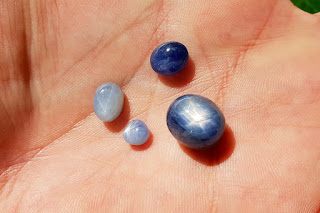How The Sparkle and Color of Your Sapphire Matters
Star sapphire get their name from the six-rayed star that’s often visible on the surface of the gem when it’s cut in a certain way. Each ray of the star represents one of the following six characteristics of your star sapphire: luster, transparency, color, cut, carat weight and clarity.
What makes a sapphire blue?
There are four primary factors that determine if a sapphire will be blue or not: 1) what mineral it comes from, 2) its level of purity, 3) its color grade, and 4) whether it has been heat treated. So when you’re shopping for sapphires look for those that contain mineral corundum (with no impurities), have a clarity grade of very slightly included or above, and have a color grade rating of between 7-9. When you find one like that be sure to check to see if there is an asterisk next to its color grading information because some sellers do try to pass off white sapphire as being blue.
Understanding Mohs Scale
Blue star sapphires are very beautiful. However, some people may wonder whether it’s worth buying a blue star sapphire with such a low rating on Mohs scale. As long as you understand what gemological tests like hardness, clarity, and carat mean, then yes—you should consider blue star sapphires with a Mohs rating of just 6.5 to be perfect for you. Here’s why: blue star sapphires get their shine and coloring from chromium rather than using corundum or sapphire as their main ingredient. Since they aren’t primarily made up of one kind of mineral but many kinds mixed together in small amounts, they are usually softer than white sapphires.
What are star sapphires?
Star sapphires are blue sapphires that exhibit a six-rayed asterism, also known as star effect. To achieve such a pattern on a blue sapphire requires all conditions to be optimal: high transparency, perfect color, no inclusions (blemishes), and precise cutting. If any one factor is lacking, you won’t see star effect. Many gemologists believe that white sapphires are actually exposed blue sapphires that have been heat treated to change their color from blue to white.
Ideal appearance in a blue star sapphire
Deep blue to violet in color with a fine, star-like whitish or silvery appearance on top of its body. Rarely are they translucent enough to see through. Usually dark-blue sapphires will have rutile inclusions that enhance their asterism (twinkling) when exposed to direct light. Transparent blue star sapphires are rare, so a flawless stone is considered more valuable than one with minor imperfections. However, too much transparency can diminish their star effect because it becomes difficult for an observer to view from certain angles under particular lighting conditions.
The importance of subtle stars
Most people will tell you that a star sapphire's color or sparkle determines its value. That is partially true. But there's one other thing that plays a big role in a blue star sapphire's price: whether or not it has subtle stars. To an untrained eye, these stars are nearly impossible to see without magnification. But, they can make all the difference in price and desirability. Most stones don't have them, which means they're typically priced lower than stones with these tiny stars inside them. However, if you want one with as many stars as possible—ideally about 5-10 small ones—that stone will be significantly more expensive than other, less visually appealing pieces with fewer subtle stars in them.


Comments
Post a Comment